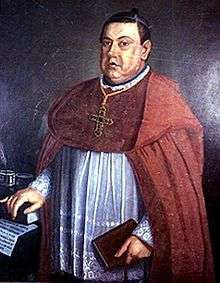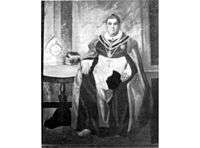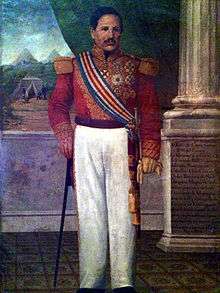Juan José de Aycinena y Piñol
Juan José de Aycinena y Piñol (Guatemala City, 29 August 1792 – Guatemala City, 17 February 1865) was an ecclesiastical and intellectual conservative in Central America. He was President of the Pontifical University of San Carlos Borromeo from 1825 to 1829 and then of the Universidad Nacional from 1840 to 1865. He was a thinker criticized by liberal historians for his strong relationship with the conservative government of General Rafael Carrera and for eliminating the possibility of getting the Central American Union which the Liberals wanted.[1][2] His participation in the government has been assessed more objectively in research conducted between 1980 and 2010.[3][4] He was heir in 1814 to the noble title of III Marquess of Aycinena, and bishop in partibus of Trajanopolis from 1859. He had a taste for law, oratorical talent and wrote over twenty works.[5][6]
Juan José de Aycinena | |
|---|---|
 Aycinena y Piñol as bishop | |
President of Pontificia Universidad de San Carlos Borromeo | |
| In office 1825–1829 | |
| President | Manuel José Arce |
| Governor | Mariano de Aycinena y Piñol (1827–1829) |
Chief Minister of Guatemala | |
| In office 14 March 1842 – 11 December 1844 | |
| Governor | Mariano Rivera Paz |
President of Pontificia Universidad de San Carlos Borromeo | |
| In office 1840–1865 | |
| Governor | Mariano Rivera Paz |
| Personal details | |
| Born | Juan José de Aycinena y Piñol 29 August 1792 Guatemala City, Guatemala |
| Died | 15 February 1865 (aged 72) Guatemala City |
| Political party | Conservative |
| Alma mater | Pontificia Universidad de San Carlos |
Juan José de Aycinena y Piñol | |
|---|---|
| Bishop of Trajanopolis | |
| Diocese | Trajanopolis |
| See | Trajanopolis |
| Appointed | 1859 |
| Installed | 1859 |
| Term ended | 1865 |
| Personal details | |
| Nationality | Guatemalan |
| Profession | Statesman, nobleman |
Ordination history of Juan José de Aycinena y Piñol | |||||||
|---|---|---|---|---|---|---|---|
| |||||||
Biography


Born in Guatemala, on 29 August 1792 . From age 22 took over the House of Aycinena and then was ordained when he was 26 years old. He may have received special education in the narrow circle of his family through preceptors, because he did not attend classes in the Tridentine Seminary, although frequently attended the benches of the University, and might have followed the courses taught by Luis de Escoto, OP. Then he studied at the Pontifical University of San Carlos of Guatemala, graduating from high school in Instituta and Law in 1811 and 1813 respectively. Later he received his doctorate in 1821 .
As a priest was pastor of the Cathedral of Guatemala for four years, and became archbishop of attorney court. Obtained the Sagrario Parish in 1822 and, even though he had been prosecutor in the ecclesiastical curia for some years, took over as synodal judge Guatemala during the years 1824 to 1859 .
He participated in the independence events in Central America in 1821, along with his uncle Mariano de Aycinena y Piñol, who was named by Manuel José Arce as Governor of Guatemala in 1827. When the liberal Honduran General Francisco Morazán invaded Guatemala in 1829, he overthrew and expelled Mariano family, the families in connection with the Aycinenas and regular orders of the Catholic Church. Aycinena y Piñol went first to Panama and then to the United States. While in America, Aycinena y Piñol wrote a series of documents collected in the book Toro Amarillo -Yellow Bull-, with which harshly criticized the liberal government of the Federation of United Provinces of Central America, directed by Morazán. He probably conceived in the US the possibility of creating a confessional republic.
Aycinena y Piñol returned to Guatemala in 1837. On his return he worked with the languishing Liberal government to restore order in the country. To that end drafted a "Declaration guarantees" which was very similar to the declaration of human rights statements made during the French Revolution; unfortunately, the results of his work were practically nil. Juan José Aycinena managed to get himself elected as a representative in the Interim Advisory Board, was a member of the Central Federal Congress in 1838 by the province of Totonicapán, and was chief minister during the regime of Mariano Rivera Paz, deputy of the Constituent Assembly of Guatemala on behalf of the University (1851–1856) and the Department of Verapaz (1856–1865). His ideas, his decisions, his writing, sketching, reflect a desire for social stability, and based on mainly Catholic values.
Conservative government of Rafael Carrera
Along with other intellectuals of the Aycinena family of Guatemala, as Pavón and Luis Batres Juarros, Aycinena y Piñol favored military leader Rafael Carrera. When the latter consolidated his rule, Aycinena worked as deputy of the Constituent Assembly. In 1840 he was appointed again president of the Universidad Nacional. Ralph Woodward wrote of him: "During Rafael Carrera's presidency Piñol and his familia – who had strong ties to the Catholic Church, had an enormous influence on Guatemala's politics and education."[7]
He worked as a public official in other positions, including Minister of Ecclesiastical Affairs and member of the Council of State (1855–1862) and was also behind the return of the Jesuits to Guatemala in 1851. Finally, was the inspiration for the first Concordat signed between an American National Government and the Holy See.[3]
Diocese
At the request of President Rafael Carrera, in 1859 he was consecrated bishop in partibus of Trajanopolis.
Death
Died in February 1865, the same year as General Rafael Carrera.
See also
References
- Rosa 1974.
- Montúfar & Salazar 1892.
- Woodward 1993.
- González Davison 2008.
- Hernández de León 1930.
- Hernández de León 1959.
- Woodward, Ralph Lee (2002) [1993]. Rafael Carrera and the Emergence of the Republic of Guatemala. Athens: University of Georgia Press.
Further reading
- Belaubre, Christopher (2009). "Juan José de Aycinena". Asociación para el Fomento de los Estudios Históricos en Centroamérica (in Spanish). Guatemala. Archived from the original (online edition) on 1 January 2015.CS1 maint: ref=harv (link)
- Chandler, David L. "Peace Through Disunion: Father Juan José de Aycinena and the Fall of the Central American Federation", The Americas 46 (Oct. 1989): 137–157.
- Chandler, David L. Juan José de Aycinena: Idealista conservador de la Guatemala del siglo XIX, translated by Victora Vázquez, Marina Vázquez, and Lucía Robelo Pereira. 1898.
- Chandler, David L. (1978). "La casa de Aycinena". Revista de la Universidad de Costa Rica (in Spanish). San José, Costa Rica.CS1 maint: ref=harv (link)
- González Davison, Fernando (2008). La montaña infinita; Carrera, caudillo de Guatemala (in Spanish). Guatemala: Artemis y Edinter. ISBN 84-89452-81-4.CS1 maint: ref=harv (link)
- Hernández de León, Federico (1959). "El capítulo de las efemérides: Segunda invasión de Morazán". Diario La Hora (in Spanish). Guatemala.CS1 maint: ref=harv (link)
- Hernández de León, Federico (1930). El libro de las efemérides (in Spanish). Tomo III. Guatemala: Tipografía Sánchez y de Guise.CS1 maint: ref=harv (link)
- López Vallecillos, Italo (1966). Gerardo Barrios y su tiempo (in Spanish). San Salvador, El Salvador: Dirección Nacional de Publicaciones del Ministerio de Educación.CS1 maint: ref=harv (link)
- Martínez Peláez, Severo (1988). Racismo y Análisis Histórico de la Definición del Indio Guatemalteco (in Spanish). Guatemala: Editorial Universitaria.CS1 maint: ref=harv (link)
- Martínez Peláez, Severo (1990). La patria del criollo; ensayo de interpretación de la realidad colonial guatemalteca (in Spanish). México: Ediciones en Marcha.CS1 maint: ref=harv (link)
- Montúfar, Lorenzo; Salazar, Ramón A. (1892). El centenario del general Francisco Morazán (in Spanish). Guatemala: Tipografía Nacional.CS1 maint: ref=harv (link)
- Rosa, Ramón (1974). Historia del Benemérito Gral. Don Francisco Morazán, ex Presidente de la República de Centroamérica (in Spanish). Tegucigalpa: Ministerio de Educación Pública, Ediciones Técnicas Centroamericana.CS1 maint: ref=harv (link)
- Stephens, John Lloyd; Catherwood, Frederick (1854). Incidents of travel in Central America, Chiapas, and Yucatan. London, England: Arthur Hall, Virtue and Co.CS1 maint: ref=harv (link)
- Woodward, Ralph Lee, Jr. (1993). Rafael Carrera and the Emergence of the Republic of Guatemala, 1821–1871 (Online edition). Athens, GA: University of Georgia Press.CS1 maint: ref=harv (link)